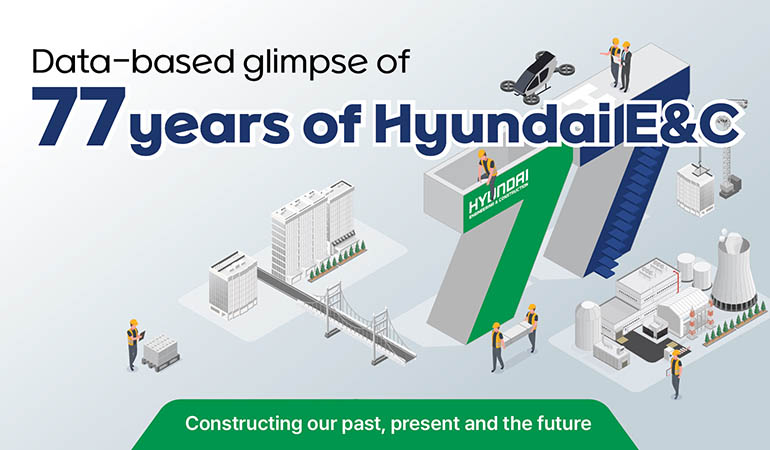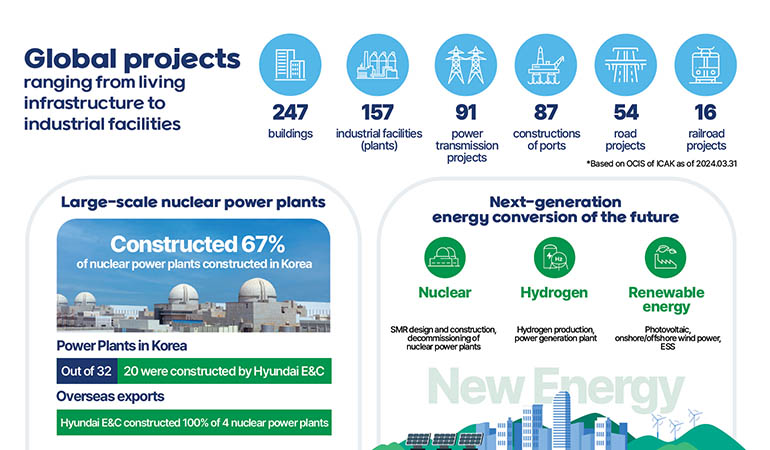
Latest News
- Hyundai E&C and KAERI Cooperate to Commercialize Next-Generation SMR, SFR
- Hyundai E&C to Fully Introduce HITTS, a Smart Safety System Specialized for Tunnels
- Hyundai E&C applies smart EV charging solution to apartment buildings for the first time
- Hyundai E&C wins one of the world’s top three design awards for four consecutive years
- Hyundai E&C Signs PPA for Solar Renewables with Glennmont D&D Solar Holdings
[77th anniversary] Data-based glimpse of 77 years of Hyundai E&C
Hyundai E&C that started as Hyundai Civil Works Company in 1947 is celebrating its 77th anniversary this year. Hyundai E&C grew alongside the history of Korea while reconstructing the cities after liberation and laying the groundworks for industrialization. Let us take an at-a-glance view of the accomplishments made by Hyundai E&C for 77 years through an infographic.

■ Growth that lasted for 77 years
![Number of employees and executives and Revenue trend by year Number of employees and executives 1947 10 employees 2024 7,204 employees *Based on business report Revenue trend by year (Unit: KRW 100 mil) 1963 436 1970 4,410 1980 10,580 1990 19,420 2000 63,849 2010 100,046 2023 296,514 *Based on 60-year history of Hyundai E&C and disclosures [Founding Chairman Chung Juyung signing theNumber of employees and executives 1947 10 employees 2024 7,204 employees *Based on business report Revenue trend by year (Unit: KRW 100 mil) 1963 436 1970 4,410 1980 10,580 1990 19,420 2000 63,849 2010 100,046 2023 296,514 *Based on 60-year history of Hyundai E&C and disclosures [Founding Chairman Chung Juyung signing the construction contract with US Forces] construction contract with US Forces]](/FileContents/EditorImg/20240603/01@2x-100_770(1).jpg)
On May 25th, 1947, Hyundai E&C was founded with the hanging of the signboard, ‘Hyundai Civil Works Company’ at the entrance of the building of ‘Hyundai Auto Service(現代自動車工業社) that was located on 106th street, Cho-dong, Jung-gu, Seoul. At the time, Hyundai Civil Works Company only had 10 or so technicians and one engineer who was formerly a teacher. The project won on the first year of establishment was worth KRW 1.53 million. It was not a grand start, but Hyundai E&C smoothly settled itself in the civil works market after liberation, where a fierce competition was being carried out. 77 years have passed since then, and now, Hyundai E&C grew to become a global construction company representing Korea with more than 7,000 employees and revenue amounting to KRW 30 trillion won, and it is continuing to expand its scope and roles in the construction industry.
■ Informing the world about the potential of K-construction

In 1965, Hyundai opened doors to overseas entrance by Korean construction by winning project to construct the Pattani Narathiwat highway in Thailand, and until now, it executed more than 850 projects in 61 nations (62 including Antarctica) to demonstrate its potential. In particular, after joining Hyundai Motor Group in 2011, it formed a steep growth curve in overseas projects, and in 2013, it achieved USD 100 billion in cumulative amount from overseas projects for the first time as a Korean construction company. Hyundai E&C is not only expanding its global influence in Middle East and Asia but also across the Americas continent, Europe and CIS, and it is once again marching forward toward the unprecedented record of achieving USD 150 billion in cumulative amount won with overseas projects.
■ Leading the living space
![Number of homes supplied by Hyundai E&C Number of homes supplied by Hyundai E&C 1961~2023 487,000 homes [Front view of Mapo Apartment, the first complex-type apartment in Korea] Leading the residential culture of Korea 1964~ First complex-type apartment in Korea – Mapo Apartment (1964) Legendary high-rise/large complex apartment - Apgujeong-dong Hyundai Apartment (1987) Leading the era of apartment brands - The H, Hillstate NO.1 in Urban maintenance [Aerial view of high-end residential The H Yeouido First] Ranked 1st place in winning projects on urban maintenance for 5 years in a row 2019-2023 KRW 27.1 trillion won in 5 years *Housing Business Division](/FileContents/EditorImg/20240603/03@2x-100_770.jpg)
The first complex-type apartment in Korea is Mapo apartment consisting of 10 buildings that emerged in the Dohwa-dong region of Mapo-gu, Seoul, in 1964. With this construction as a starting point, Hyundai E&C contributed in ushering in the apartment era in Korea, and since then, it supplied staggering 500,000 homes in the form of apartments to lead the residential advancement in Korea. ‘Hyundai’ including Hyundai Apartment and Hyundai Hometown boasts of strong brand power to the extent that it is commonly known as the icon of apartments, and this continued with Hillstate in 2006 and premium brand The H in 2015, proposing new values and standards for residences. Such efforts of Hyundai E&C led the company to rank 1st place in winning the urban maintenance project for 5 years in a row from 2019 to 2023, further solidifying its position.
■ Constructing a better tomorrow with exceptional technological capabilities

Hyundai E&C is actively taking part in construction of infrastructure that changes our lives. In addition to projects in Korea, it executed overseas mega projects to further elevate its stature, and the Hyundai E&C is involved in diverse types of projects, ranging from landmark structures of various nations such as hotels, hospitals and museums, to marine and port constructions that were known to have expanded the national territory of Singapore by outstanding 7% and large-scale plant constructions like Amiral project that recorded more than USD 5 billion. Recently, following the Barakah Nuclear Energy Plant of UAE, the first nuclear power plant to be exported from Korea, Hyundai E&C is expected to win projects in Bulgaria as well, and thus, the trajectory for large-scale nuclear power plants is also gaining traction. Moreover, Hyundai E&C is doing its utmost in securing competitiveness in the next generation energy sector including SMR, renewable energy such as photovoltaic and offshore wind power, and hydrogen production base. Eyes are on how far Hyundai E&C will advance in terms of its growth and challenging spirit that transcends limits.


